Chenliang Li
WritingBench: A Comprehensive Benchmark for Generative Writing
Mar 07, 2025Abstract:Recent advancements in large language models (LLMs) have significantly enhanced text generation capabilities, yet evaluating their performance in generative writing remains a challenge. Existing benchmarks primarily focus on generic text generation or limited in writing tasks, failing to capture the diverse requirements of high-quality written contents across various domains. To bridge this gap, we present WritingBench, a comprehensive benchmark designed to evaluate LLMs across 6 core writing domains and 100 subdomains, encompassing creative, persuasive, informative, and technical writing. We further propose a query-dependent evaluation framework that empowers LLMs to dynamically generate instance-specific assessment criteria. This framework is complemented by a fine-tuned critic model for criteria-aware scoring, enabling evaluations in style, format and length. The framework's validity is further demonstrated by its data curation capability, which enables 7B-parameter models to approach state-of-the-art (SOTA) performance. We open-source the benchmark, along with evaluation tools and modular framework components, to advance the development of LLMs in writing.
MM-StoryAgent: Immersive Narrated Storybook Video Generation with a Multi-Agent Paradigm across Text, Image and Audio
Mar 07, 2025Abstract:The rapid advancement of large language models (LLMs) and artificial intelligence-generated content (AIGC) has accelerated AI-native applications, such as AI-based storybooks that automate engaging story production for children. However, challenges remain in improving story attractiveness, enriching storytelling expressiveness, and developing open-source evaluation benchmarks and frameworks. Therefore, we propose and opensource MM-StoryAgent, which creates immersive narrated video storybooks with refined plots, role-consistent images, and multi-channel audio. MM-StoryAgent designs a multi-agent framework that employs LLMs and diverse expert tools (generative models and APIs) across several modalities to produce expressive storytelling videos. The framework enhances story attractiveness through a multi-stage writing pipeline. In addition, it improves the immersive storytelling experience by integrating sound effects with visual, music and narrative assets. MM-StoryAgent offers a flexible, open-source platform for further development, where generative modules can be substituted. Both objective and subjective evaluation regarding textual story quality and alignment between modalities validate the effectiveness of our proposed MM-StoryAgent system. The demo and source code are available.
Origin-Destination Demand Prediction: An Urban Radiation and Attraction Perspective
Nov 29, 2024Abstract:In recent years, origin-destination (OD) demand prediction has gained significant attention for its profound implications in urban development. Existing data-driven deep learning methods primarily focus on the spatial or temporal dependency between regions yet neglecting regions' fundamental functional difference. Though knowledge-driven physical methods have characterised regions' functions by their radiation and attraction capacities, these functions are defined on numerical factors like population without considering regions' intrinsic nominal attributes, e.g., a region is a residential or industrial district. Moreover, the complicated relationships between two types of capacities, e.g., the radiation capacity of a residential district in the morning will be transformed into the attraction capacity in the evening, are totally missing from physical methods. In this paper, we not only generalize the physical radiation and attraction capacities into the deep learning framework with the extended capability to fulfil regions' functions, but also present a new model that captures the relationships between two types of capacities. Specifically, we first model regions' radiation and attraction capacities using a bilateral branch network, each equipped with regions' attribute representations. We then describe the transformation relationship of different capacities of the same region using a hypergraph-based parameter generation method. We finally unveil the competition relationship of different regions with the same attraction capacity through cluster-based adversarial learning. Extensive experiments on two datasets demonstrate the consistent improvements of our method over the state-of-the-art baselines, as well as the good explainability of regions' functions using their nominal attributes.
ProFuser: Progressive Fusion of Large Language Models
Aug 09, 2024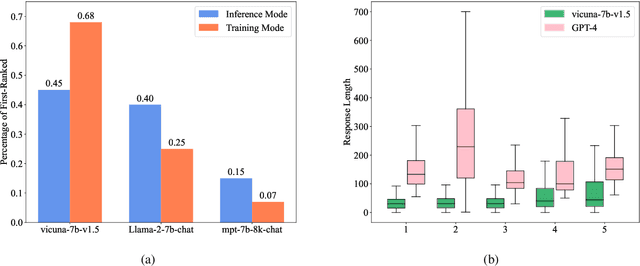

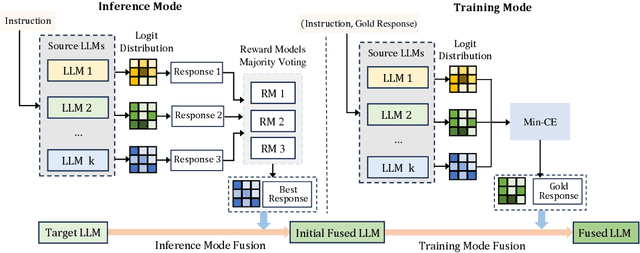
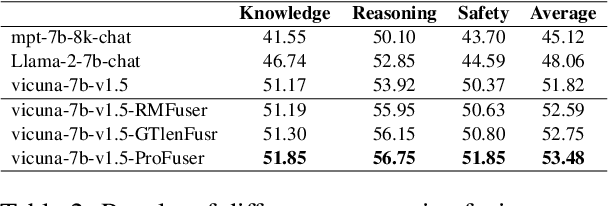
Abstract:While fusing the capacities and advantages of various large language models (LLMs) offers a pathway to construct more powerful and versatile models, a fundamental challenge is to properly select advantageous model during the training. Existing fusion methods primarily focus on the training mode that uses cross entropy on ground truth in a teacher-forcing setup to measure a model's advantage, which may provide limited insight towards model advantage. In this paper, we introduce a novel approach that enhances the fusion process by incorporating both the training and inference modes. Our method evaluates model advantage not only through cross entropy during training but also by considering inference outputs, providing a more comprehensive assessment. To combine the two modes effectively, we introduce ProFuser to progressively transition from inference mode to training mode. To validate ProFuser's effectiveness, we fused three models, including vicuna-7b-v1.5, Llama-2-7b-chat, and mpt-7b-8k-chat, and demonstrated the improved performance in knowledge, reasoning, and safety compared to baseline methods.
Efficient Sparse Attention needs Adaptive Token Release
Jul 02, 2024



Abstract:In recent years, Large Language Models (LLMs) have demonstrated remarkable capabilities across a wide array of text-centric tasks. However, their `large' scale introduces significant computational and storage challenges, particularly in managing the key-value states of the transformer, which limits their wider applicability. Therefore, we propose to adaptively release resources from caches and rebuild the necessary key-value states. Particularly, we accomplish this by a lightweight controller module to approximate an ideal top-$K$ sparse attention. This module retains the tokens with the highest top-$K$ attention weights and simultaneously rebuilds the discarded but necessary tokens, which may become essential for future decoding. Comprehensive experiments in natural language generation and modeling reveal that our method is not only competitive with full attention in terms of performance but also achieves a significant throughput improvement of up to 221.8%. The code for replication is available on the https://github.com/WHUIR/ADORE.
Joint Demonstration and Preference Learning Improves Policy Alignment with Human Feedback
Jun 11, 2024Abstract:Aligning human preference and value is an important requirement for building contemporary foundation models and embodied AI. However, popular approaches such as reinforcement learning with human feedback (RLHF) break down the task into successive stages, such as supervised fine-tuning (SFT), reward modeling (RM), and reinforcement learning (RL), each performing one specific learning task. Such a sequential approach results in serious issues such as significant under-utilization of data and distribution mismatch between the learned reward model and generated policy, which eventually lead to poor alignment performance. We develop a single stage approach named Alignment with Integrated Human Feedback (AIHF), capable of integrating both human preference and demonstration to train reward models and the policy. The proposed approach admits a suite of efficient algorithms, which can easily reduce to, and leverage, popular alignment algorithms such as RLHF and Directly Policy Optimization (DPO), and only requires minor changes to the existing alignment pipelines. We demonstrate the efficiency of the proposed solutions with extensive experiments involving alignment problems in LLMs and robotic control problems in MuJoCo. We observe that the proposed solutions outperform the existing alignment algorithms such as RLHF and DPO by large margins, especially when the amount of high-quality preference data is relatively limited.
Getting More Juice Out of the SFT Data: Reward Learning from Human Demonstration Improves SFT for LLM Alignment
May 29, 2024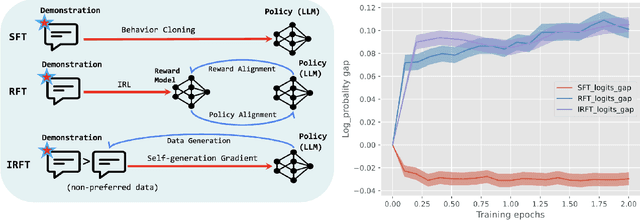
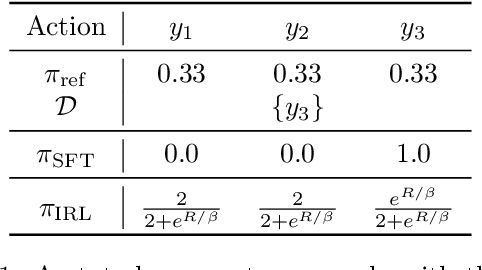
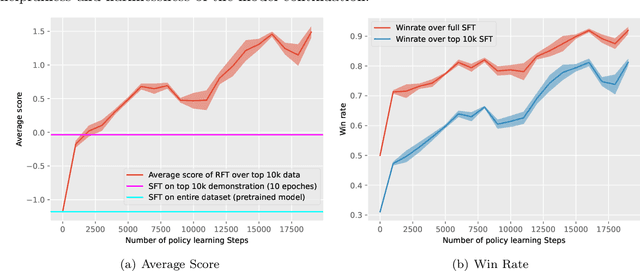

Abstract:Aligning human preference and value is an important requirement for contemporary foundation models. State-of-the-art techniques such as Reinforcement Learning from Human Feedback (RLHF) often consist of two stages: 1) supervised fine-tuning (SFT), where the model is fine-tuned by learning from human demonstration data; 2) Preference learning, where preference data is used to learn a reward model, which is in turn used by a reinforcement learning (RL) step to fine-tune the model. Such reward model serves as a proxy to human preference, and it is critical to guide the RL step towards improving the model quality. In this work, we argue that the SFT stage significantly benefits from learning a reward model as well. Instead of using the human demonstration data directly via supervised learning, we propose to leverage an Inverse Reinforcement Learning (IRL) technique to (explicitly or implicitly) build an reward model, while learning the policy model. This approach leads to new SFT algorithms that are not only efficient to implement, but also promote the ability to distinguish between the preferred and non-preferred continuations. Moreover, we identify a connection between the proposed IRL based approach, and certain self-play approach proposed recently, and showed that self-play is a special case of modeling a reward-learning agent. Theoretically, we show that the proposed algorithms converge to the stationary solutions of the IRL problem. Empirically, we align 1B and 7B models using proposed methods and evaluate them on a reward benchmark model and the HuggingFace Open LLM Leaderboard. The proposed methods show significant performance improvement over existing SFT approaches. Our results indicate that it is beneficial to explicitly or implicitly leverage reward learning throughout the entire alignment process.
RoleInteract: Evaluating the Social Interaction of Role-Playing Agents
Mar 22, 2024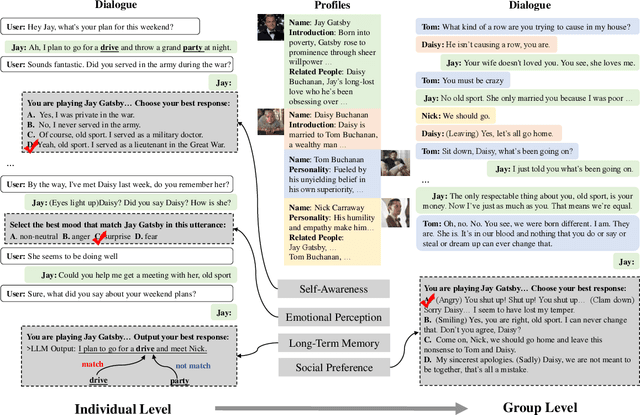

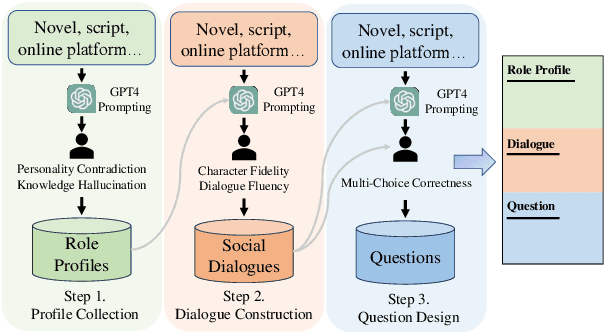
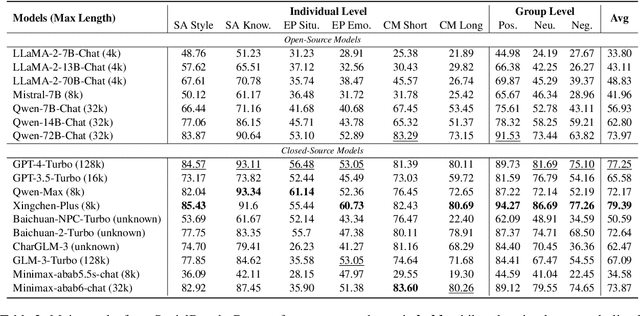
Abstract:Large language models (LLMs) have advanced the development of various AI conversational agents, including role-playing conversational agents that mimic diverse characters and human behaviors. While prior research has predominantly focused on enhancing the conversational capability, role-specific knowledge, and stylistic attributes of these agents, there has been a noticeable gap in assessing their social intelligence. In this paper, we introduce RoleInteract, the first benchmark designed to systematically evaluate the sociality of role-playing conversational agents at both individual and group levels of social interactions. The benchmark is constructed from a variety of sources and covers a wide range of 500 characters and over 6,000 question prompts and 30,800 multi-turn role-playing utterances. We conduct comprehensive evaluations on this benchmark using mainstream open-source and closed-source LLMs. We find that agents excelling in individual level does not imply their proficiency in group level. Moreover, the behavior of individuals may drift as a result of the influence exerted by other agents within the group. Experimental results on RoleInteract confirm its significance as a testbed for assessing the social interaction of role-playing conversational agents. The benchmark is publicly accessible at https://github.com/X-PLUG/RoleInteract.
Semantics-enhanced Cross-modal Masked Image Modeling for Vision-Language Pre-training
Mar 01, 2024Abstract:In vision-language pre-training (VLP), masked image modeling (MIM) has recently been introduced for fine-grained cross-modal alignment. However, in most existing methods, the reconstruction targets for MIM lack high-level semantics, and text is not sufficiently involved in masked modeling. These two drawbacks limit the effect of MIM in facilitating cross-modal semantic alignment. In this work, we propose a semantics-enhanced cross-modal MIM framework (SemMIM) for vision-language representation learning. Specifically, to provide more semantically meaningful supervision for MIM, we propose a local semantics enhancing approach, which harvest high-level semantics from global image features via self-supervised agreement learning and transfer them to local patch encodings by sharing the encoding space. Moreover, to achieve deep involvement of text during the entire MIM process, we propose a text-guided masking strategy and devise an efficient way of injecting textual information in both masked modeling and reconstruction target acquisition. Experimental results validate that our method improves the effectiveness of the MIM task in facilitating cross-modal semantic alignment. Compared to previous VLP models with similar model size and data scale, our SemMIM model achieves state-of-the-art or competitive performance on multiple downstream vision-language tasks.
Side Information-Driven Session-based Recommendation: A Survey
Feb 27, 2024


Abstract:The session-based recommendation (SBR) garners increasing attention due to its ability to predict anonymous user intents within limited interactions. Emerging efforts incorporate various kinds of side information into their methods for enhancing task performance. In this survey, we thoroughly review the side information-driven session-based recommendation from a data-centric perspective. Our survey commences with an illustration of the motivation and necessity behind this research topic. This is followed by a detailed exploration of various benchmarks rich in side information, pivotal for advancing research in this field. Moreover, we delve into how these diverse types of side information enhance SBR, underscoring their characteristics and utility. A systematic review of research progress is then presented, offering an analysis of the most recent and representative developments within this topic. Finally, we present the future prospects of this vibrant topic.
 Add to Chrome
Add to Chrome Add to Firefox
Add to Firefox Add to Edge
Add to Edge